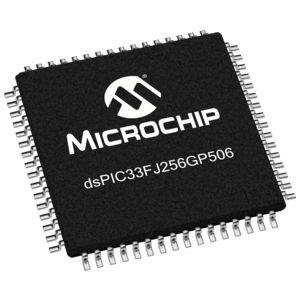 购物车0
购物车0
Please consider this device
dsPIC33F General Purpose Digital Signal Controller (DSC) with seamless migration options to PIC24 MCUs and dsPIC30F DSCs in similar packages.
Operating Range:DC – 40 MIPS (40 MIPS @ 3.0-3.6V, -40°C to +85°C)
Industrial temperature range (-40°C to +85°C)High-Performance DSC CPU:
Modified Harvard architecture
C compiler optimized instruction set
16-bit wide data path
24-bit wide instructions
Linear program memory addressing up to 4M instruction words
Linear data memory addressing up to 64 Kbytes
83 base instructions: mostly 1 word/1 cycle
Sixteen 16-bit General Purpose Registers
Two 40-bit accumulators:- With rounding and saturation options
Flexible and powerful addressing modes:- Indirect, Modulo and Bit-Reversed
Software stack
16 x 16 fractional/integer multiply operations
32/16 and 16/16 divide operations
Single-cycle multiply and accumulate:- Accumulator write back for DSP operations- Dual data fetch
Up to ±16-bit shifts for up to 40-bit dataDirect Memory Access (DMA):
8-channel hardware DMA:
2 Kbytes dual ported DMA buffer area (DMA RAM) to store data transferred via DMA:- Allows data transfer between RAM and a peripheral while CPU is executing code (no cycle stealing)
Most peripherals support DMAInterrupt Controller:
5-cycle latency
118 interrupt vectors
Up to 67 available interrupt sources
Up to 5 external interrupts
7 programmable priority levels
5 processor exceptionsDigital I/O:
Wake-up/Interrupt-on-Change on up to 24 pins
Output pins can drive from 3.0V to 3.6V
All digital input pins are 5V tolerant
4 mA sink on all I/O pinsSystem Management:
Flexible clock options:- External, crystal, resonator, internal RC- Fully integrated PLL- Extremely low jitter PLL
Power-up Timer
Oscillator Start-up Timer/Stabilizer
Watchdog Timer with its own RC oscillator
Fail-Safe Clock Monitor
Reset by multiple sourcesPower Management:
On-chip 2.5V voltage regulator
Switch between clock sources in real time
Idle, Sleep and Doze modes with fast wake-upTimers/Capture/Compare/PWM:
Timer/Counters, up to nine 16-bit timers:- Can pair up to make four 32-bit timers- 1 timer runs as Real-Time Clock with external 32.768 kHz oscillator- Programmable prescaler
Input Capture (up to 8 channels):- Capture on up, down or both edges- 16-bit capture input functions- 4-deep FIFO on each capture
Output Compare (up to 8 channels):- Single or Dual 16-Bit Compare mode- 16-bit Glitchless PWM modeCommunication Modules:
3-wire SPI (up to 2 modules):- Framing supports I/O interface to simple codecs- Supports 8-bit and 16-bit data- Supports all serial clock formats and sampling modes
I2C™ (up to 2 modules):- Full Multi-Master Slave mode support- 7-bit and 10-bit addressing- Bus collision detection and arbitration- Integrated signal conditioning- Slave address masking
UART (up to 2 modules):- Interrupt on address bit detect- Interrupt on UART error- Wake-up on Start bit from Sleep mode- 4-character TX and RX FIFO buffers- LIN bus support- IrDA® encoding and decoding in hardware- High-Speed Baud mode- Hardware Flow Control with CTS and RTS
Data Converter Interface (DCI) module:- Codec interface- Supports I2S and AC’97 protocols- Up to 16-bit data words, up to 16 words per frame- 4-word deep TX and RX buffers
Enhanced CAN (ECAN™ module) 2.0B active (up to 2 modules):- Up to 8 transmit and up to 32 receive buffers- 16 receive filters and 3 masks- Loopback, Listen Only and Listen All Messages modes for diagnostics and bus monitoring- Wake-up on CAN message- Automatic processing of Remote Transmission Requests- FIFO mode using DMA- DeviceNet™ addressing supportAnalog-to-Digital Converters (ADCs):
Up to two ADC modules in a device
10-bit, 1.1 Msps or 12-bit, 500 Ksps conversion:- 2, 4 or 8 simultaneous samples- Up to 32 input channels with auto-scanning- Conversion start can be manual or synchronized with 1 of 4 trigger sources- Conversion possible in Sleep mode- ±2 LSb max integral nonlinearity- ±1 LSb max differential nonlinearityCMOS Flash Technology:
Low-power, high-speed Flash technology
Fully static design
3.3V (±10%) operating voltage
Industrial temperature
Low-power consumption

DSPIC33FJ256GP506 封装图
| 型号 | 制造商 | 描述 | 购买 |
|---|---|---|---|
| DSPIC33FJ256GP506T-I/PT | Wakefield-Vette | PRECISIONCLAMP | 立即购买 |
| DSPIC33FJ256GP506-I/PT | SSI | SENSOR 15PSI M12-1.5 6G .5-4.5V | 立即购买 |
Microchip公司的dsPIC33FJ06GS101 / X02和dsPIC33FJ16GSX02 / X04包括了DSP功能和高性能16位MCU架构,在3.0-3.6V时可达40MIPS,大约有35个可编数字I / O,闪存容量16KB,集成了dsPIC33F系列产品的主要特性,其中图是集成了高速PWM模块,中断控制器,...
今天推荐的视频 将简要介绍智能嵌入式LED(ISELED)技术,以及我们使用dsPIC33CK系列DSC和ISELED实现汽车环境照明的解决方案。 一起来看看吧! 更多更全视频尽在
dsPIC33FJ16MC101 / 102数字信号控制器(DSC)装置。dsPIC33F器件包含具有高性能16位微控制器(MCU)架构的广泛的数字信号处理器(DSP)功能。
Microchip Technology dsPIC33CDVC256MP506集成电机驱动器将数字信号控制器 (DSC) 与设计用于3相BLDC电机控制的全桥MOSFET栅极驱动器以及用于汽车
三相交错带同步整流的半桥LLC拓扑结构示意如下,需要6对PWM波。对于dsPIC33CK256MP508 可以用PG1、PG3和PG5作为主管PWM驱动,PG2、PG4和PG6作为同步管PWM驱动。
AI服务器市场的持续增长推动了高功率服务器电源的需求,3KW单机服务器电源已逐步普及。 全数字电源凭借MCU控制的精准性和灵活性,成为解决这一难题的关键。 大联大品佳集团基于Microchip dsPIC33CK256MP506开发了一款高功率密度的3.3KW双向图腾柱PFC逆变电源方案,成为当前市场上性价比最高的选
... 70 MIPS 3.0V 至 3.6V, -40C 至 +125C, DC 至 60 MIPS 内核:16 位 dsPIC33E/PIC24E CPU 高效代码型 (C 和汇编)架构 两个 40 位宽累加器 带双数据取操作的单周期 (MAC/MPY) 单周期混合符号乘法和硬件除法 32 位乘法支持 时钟管理 1.0% 精度内...
...备的保护电源。本文介绍了UPS参考设计的主要指标,采用dsPIC33FJ16GS504的离线UPS机箱图,电路图,材料清单和PCB元件布局图。